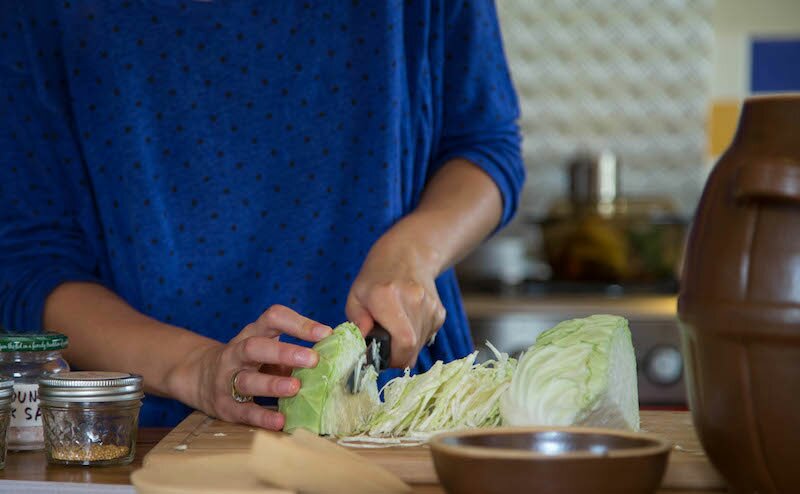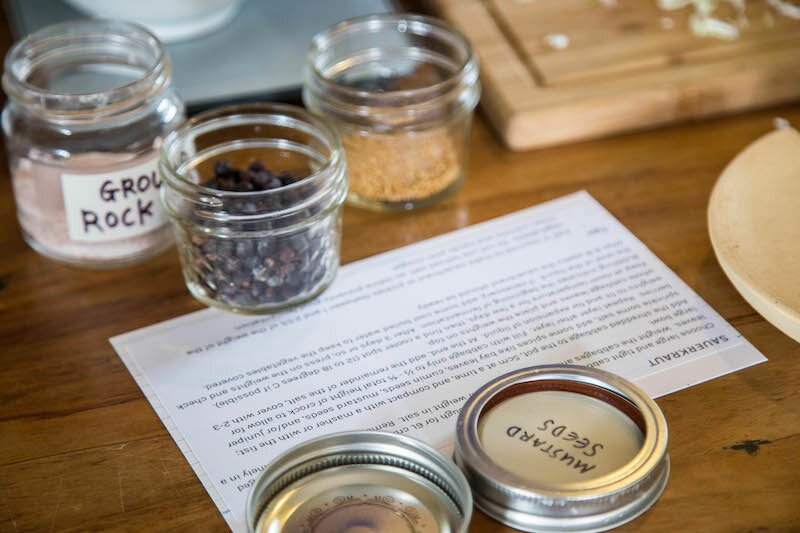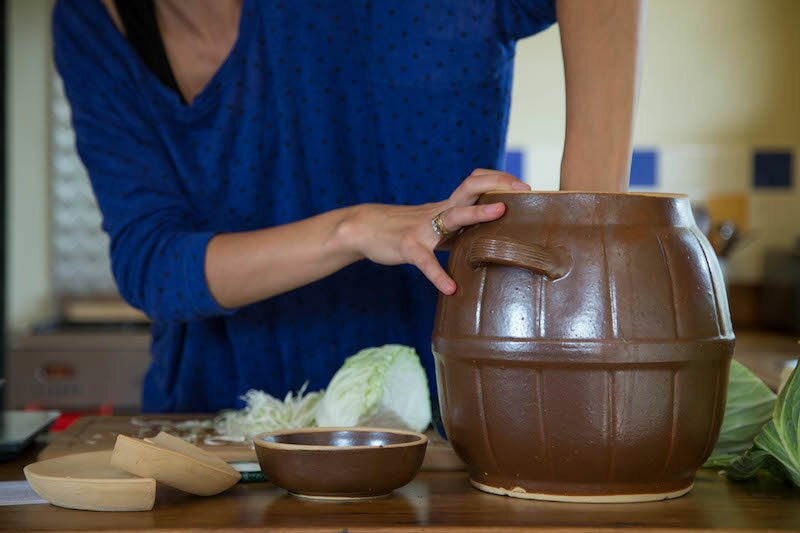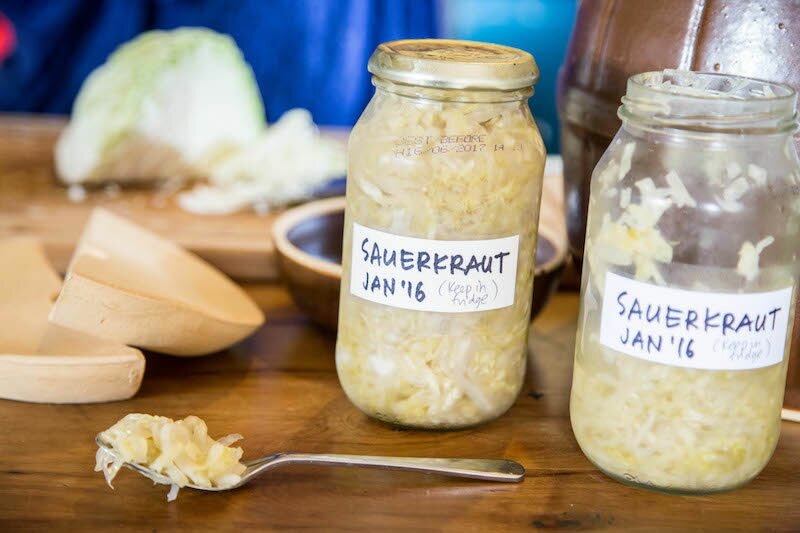Thanks to my Dutch father, I have been eating sauerkraut for as long as I can remember. Certainly, long before it became fashionable as a probiotic superfood! My dad used to serve it up mixed through mashed potato with a rookworst sausage and gravy on top. Just describing it makes me drool! It was the ultimate winter comfort food. After I left home for university I rarely ate it as it’s not something you usually notice at the supermarket. Fast forward two decades, and what do I notice in the fridge of my local organic store? Sauerkraut!
It caught my attention because:
a. I never knew sauerkraut was worthy of featuring in an organic shop;
b. It was packed in glass jars and labelled with stylish graphics;
c. It cost $15 for a jar I would’ve finished in one meal, easily. Eek!
Closer inspection revealed this was no ordinary sauerkraut, but RAW sauerkraut. So of course I did some googling and discovered that sauerkraut is considered a probiotic superfood that is extremely healthy for you and your digestive system. Wow, I’d been eating a superfood all my life! And I loved eating it too! Ah, but there was a catch. Of course. It would seem that not all sauerkraut is created equal. I learned that while traditional sauerkraut was fermented, the tinned, shelf-stable sauerkraut I’d grown up with was more likely preserved using vinegar (rather than fermentation), or fermented but then pasteurised as part of the canning process. This explained why raw sauerkraut was more than three times’ the price of the more familiar tinned version. It’s the fermentation process that unlocks the beneficial enzymes, B-vitamins, and numerous strains of probiotics; however, just like kefir and kombucha, the fermentation process doesn’t stop so the flavour is constantly developing. Pasteurisation halts the fermentation process, ensuring a shelf-stable product with a predictable flavour but it does so by killing the live (beneficial) bacteria, d’oh.
Well, I’m all for eating healthy food that I consider to be dee—licious! But $15 per serve was just a bit pricey for frugal-me. So I decided to invest in a sauerkraut crock and make my own, extremely affordable, raw sauerkraut. The crock was expensive, because it’s designed with a water well around the rim. This acts as an airlock, allowing gases caused by fermentation to escape, without letting fresh air in. There are cheaper ways to set up vessels with airlocks suitable for fermentation, but I decided to go traditional, authentic, and big. Luckily for me, I had a father who was happy to contribute to the cost of a 6L crock in exchange for a free and fairly constant source of sauerkraut!
The process of making sauerkraut is so simple, and incredibly affordable. I would be lying if I said I enjoy finely slicing 4 cabbages one after the other, but I only have to do it three to four times a year in order to have a constant supply, so I consider it short-term suffering for long-term benefits! While it is a very simple exercise to make sauerkraut, I should also note that as with all fermented food preparation, you do need to be careful to work in a nice CLEAN environment, with nice CLEAN hands (nb. if you haven’t already read it, I wrote a post about cleanliness and soap just recently).
So, here’s how I make my sauerkraut:
First I weigh my cabbages. This is so I can figure out how much salt I will need in total. I set aside 1% of their weight in rock/sea salt (not iodised!). Then I set to work chopping up the cabbages, cutting out the stalks, and slicing them as finely as I possibly can.

The next step is to fill the crock with shredded cabbage, creating layers of cabbage, salt, and desired spices (so far I’ve only ever used mustard seeds and juniper berries), compacting it with my fist as I go.

Once all the cabbage and salt is in the crock, it should hopefully be about 2/3 full. I cover the shredded cabbage with a few clean, whole leaves I’ve set aside, and then put clay weights on top. Compacting the shredded cabbage along the way should mean that by the time you’ve finished putting it all in, there is enough brine (the salt draws water out of the shredded cabbage to make the brine) to cover all the cabbage. It’s amazing how much liquid comes out of the cabbage!

Now I can put the lid on and fill the water well with water/brine. I let it sit out on the kitchen counter for a few days, enjoying the clinking of the clay lid every time an air bubble pops out through the water! Then my kraut-filled crock gets moved to our cooler (south-facing) pantry room behind the kitchen.

My dad, the true Dutchman, prefers my sauerkraut to be truly sour with no salty taste at all. This requires a fermentation period of at least 10 weeks. When it tastes just the way we like it, I scoop the kraut into jars and store them in the refrigerator until we’re ready to eat it. This slows down the fermentation process in the meantime, and I’ve had nothing but compliments from all who have tried it!
If you’re curious, I recommend you have a go; although perhaps not 6L for your first attempt unless you know for sure you’ll love it! If you’re interested in learning more about sauerkraut, how to make it, and why it’s considered so healthy, here are some articles I enjoyed reading myself:
How to make it:
http://www.wildfermentation.com/making-sauerkraut-2/
http://toriavey.com/how-to/2013/06/how-to-ferment-cabbage-and-make-sauerkraut/
Why it’s so awesome:
http://articles.mercola.com/sites/articles/archive/2013/06/01/fermented-vegetables.aspx
http://www.superfoods-for-superhealth.com/sauerkraut.html
Keen to have a go? I’ve put together a fermenting kit with comprehensive instructions on how to make sauerkraut, for sale in the Mrs Goodness Shop. The 850mL fermenting vessel is just the right size to fit a half cabbage worth of kraut, and when it’s done you can just switch the lids over and pop it straight in the fridge! Easy peasy 😉 .
And, over on my YouTube channel, I’ll talk you through the sauerkraut-making process with one hand while I hold the camera in my other hand, haha!
Yummy! Please keep a couple of jars for me next time!!!
Of course!!! For you, anything x
Instead of a crock, i use a food grade 5 gal bucket covered with a heavy towel. works great.just saying for those who dont have a crock. i put my kraut in zip lock baggies and freeze it.
Thanks for sharing your tip! I am, however, trying to reduce the amount of plastic that’s in my home and I encourage others to do the same, despite the fact that it makes so many things more affordable. I explained why in a couple of blog posts I’ve written: “Why I Choose to Use Glass in my Kitchen” and “The Problem with Plastic”.
Your pictures make it look like a cooking show except a freeze frame instead of a video! Very nice pictures that do a good job of hooking the reader in and making me want to make some sauerkraut! Thank you for your recipe and I hope to give it a try pretty soon. I just need to finish off my last batch before I do!